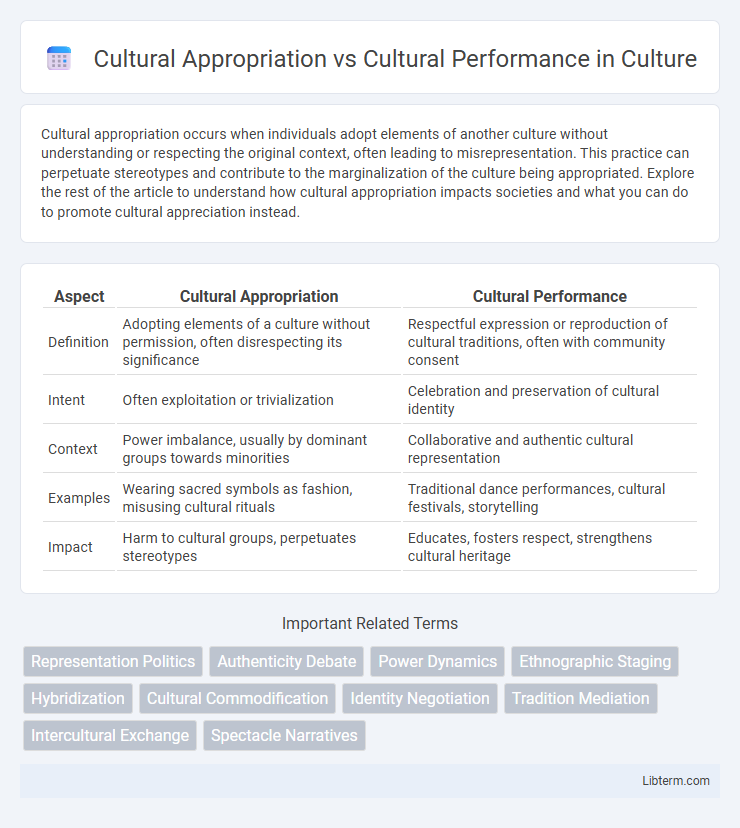Cultural appropriation occurs when individuals adopt elements of another culture without understanding or respecting the original context, often leading to misrepresentation. This practice can perpetuate stereotypes and contribute to the marginalization of the culture being appropriated. Explore the rest of the article to understand how cultural appropriation impacts societies and what you can do to promote cultural appreciation instead.
Table of Comparison
| Aspect | Cultural Appropriation | Cultural Performance |
|---|---|---|
| Definition | Adopting elements of a culture without permission, often disrespecting its significance | Respectful expression or reproduction of cultural traditions, often with community consent |
| Intent | Often exploitation or trivialization | Celebration and preservation of cultural identity |
| Context | Power imbalance, usually by dominant groups towards minorities | Collaborative and authentic cultural representation |
| Examples | Wearing sacred symbols as fashion, misusing cultural rituals | Traditional dance performances, cultural festivals, storytelling |
| Impact | Harm to cultural groups, perpetuates stereotypes | Educates, fosters respect, strengthens cultural heritage |
Understanding Cultural Appropriation: Definition and Scope
Cultural appropriation refers to the adoption or use of elements from one culture by members of another culture, often without permission and in a way that can perpetuate stereotypes or disrespect the original meaning. This concept encompasses behaviors where dominant groups borrow cultural symbols from marginalized communities, risking the commodification and distortion of those traditions. Understanding its scope requires recognizing power imbalances, historical context, and the consequences for cultural identity and authenticity.
What Constitutes Cultural Performance in Modern Society
Cultural performance in modern society involves the respectful and informed expression of cultural traditions, rituals, and arts that honor the original community's values and context. It emphasizes authentic engagement, education, and collaboration with members of the culture being represented, ensuring practices are not distorted or commodified. This contrasts sharply with cultural appropriation, which often involves the uncontextualized use of cultural symbols or practices for personal gain or aesthetic purposes without permission or understanding.
Historical Perspectives on Cultural Exchange
Historical perspectives on cultural exchange reveal that cultural appropriation involves adopting elements of a marginalized culture without permission or understanding, often perpetuating stereotypes and power imbalances. In contrast, cultural performance signifies a respectful and consensual sharing of traditions, usually within contexts that honor the origin culture's significance and maintain authenticity. Examining global histories highlights the complexities where colonialism and trade have influenced cultural interactions, emphasizing the importance of context and intent in differentiating appropriation from performance.
Key Differences Between Appropriation and Appreciation
Cultural appropriation occurs when elements of a marginalized culture are taken out of context and used without understanding or respect, often reinforcing stereotypes or power imbalances. Cultural performance, by contrast, involves a respectful, informed presentation of cultural practices that honors the traditions and intentions behind them. Key differences include the intent behind the use, the level of cultural understanding, and the impact on the source community's representation and dignity.
Impact of Cultural Appropriation on Marginalized Communities
Cultural appropriation often exploits marginalized communities by stripping cultural elements of their original significance and commodifying them, leading to misrepresentation and disrespect. This practice reinforces power imbalances and perpetuates systemic inequalities by allowing dominant groups to benefit from marginalized cultures without acknowledgment or reciprocity. In contrast, cultural performance involves respectful sharing and preservation of cultural expressions, fostering understanding and appreciation rather than harm.
The Role of Intent in Cultural Expression
The role of intent in cultural expression distinguishes cultural appropriation from cultural performance by emphasizing respect and understanding towards the originating culture. Cultural performance involves conscious appreciation and accurate representation intended to honor and celebrate cultural heritage, whereas cultural appropriation often entails exploitation or misrepresentation driven by ignorance or commodification. Intent shapes the ethical boundaries by determining whether the cultural elements are shared with sensitivity or used in a way that perpetuates stereotypes and power imbalances.
Case Studies: Controversies and Celebrations
Case studies of cultural appropriation versus cultural performance reveal complex dynamics where specific instances, such as fashion brands using Indigenous designs without permission, sparked controversies highlighting disrespect and exploitation. Conversely, events like the Maori haka performed by non-Maori groups under guided cultural exchange demonstrate celebrations of cultural performance that honor and preserve traditions. Analyzing contexts, power dynamics, and community consent is essential in differentiating harmful appropriation from respectful cultural appreciation.
Navigating the Fine Line: Respect vs. Exploitation
Navigating the fine line between cultural appropriation and cultural performance requires a deep understanding of respect, context, and intent behind the cultural expression. Cultural performance involves authentic engagement and acknowledgment of the source culture's significance, whereas cultural appropriation often exploits cultural symbols without permission or accurate representation, leading to harm and misinterpretation. Prioritizing meaningful collaboration and education helps ensure cultural appreciation rather than commodification or disrespect.
Ethical Guidelines for Engaging with Other Cultures
Engaging with other cultures ethically requires understanding the distinction between cultural appropriation and cultural performance, emphasizing respect, consent, and context. Ethical guidelines encourage obtaining permission from cultural communities, acknowledging origins, and avoiding stereotypes or commodification of cultural elements. Prioritizing genuine cultural exchange fosters mutual respect and preserves the integrity of cultural expressions.
Moving Forward: Fostering Respectful Cultural Interactions
Fostering respectful cultural interactions requires recognizing the distinctions between cultural appropriation and cultural performance by prioritizing consent, context, and mutual respect in sharing traditions. Communities benefit from open dialogues that emphasize cultural appreciation, education, and acknowledgment of historical power dynamics to avoid exploitation. Sustained collaboration encourages authentic engagement and supports cultural preservation while promoting inclusivity and diversity in creative expressions.
Cultural Appropriation Infographic

 libterm.com
libterm.com